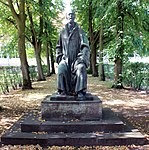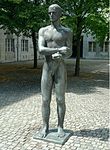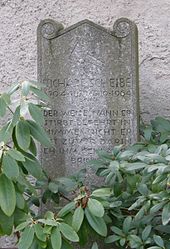Richard Disk
Richard Scheibe (born April 19, 1879 in Chemnitz , † October 6, 1964 in Berlin ) was a German sculptor and medalist .
Life
Richard Scheibe was the son of the Saxon officer Albert Bruno Scheibe (1846-1933) and his wife Isidora Scheibe, née Rau (1853-1924), born in Chemnitz. His older brother was the future writer Dr. Albert Scheibe (born 1877). After attending the Vitzthumschen Gymnasium in Dresden, of which his grandfather was director until 1869, he passed his Abitur in Dresden in 1896. He then studied painting from 1896 to 1899 at the Dresden Art Academy and later in Munich , but then turned to sculpture. In 1914 he became a member of the Berlin Secession , which also exhibited his works. In 1924, at the suggestion of Peter Behrens , who was then the architect of IG Farbenindustrie AG in Frankfurt am Main , he designed the memorial for the company's employees who died in the First World War .
From 1925 to 1933 he was a professor at the Städelschule in Frankfurt am Main . When Reich President Friedrich Ebert died in 1925, the city of Frankfurt commissioned him to create a memorial . The larger than life bronze figure of a naked youth was attached to the outer wall of the Paulskirche in Frankfurt in 1926 , which led to violent protests by the church council. The memorial was dismantled and put into storage. In 1936, Scheibe actually wanted to melt down the monument, which he had had to design in just seven days because of the upcoming Reichstag elections and which he did not consider successful. However, it was preserved and is now in the permanent exhibition of the Historical Museum in Frankfurt. For the 25th anniversary of Friedrich Ebert's death in 1950, he made a new version that was attached to the old square at the Paulskirche and is still there today.
Striding ( convalescent ), Am Karlsbad / Schöneberger Ufer, Berlin-Tiergarten , 1935
Dawn in the Mannheim Sculpture Garden , bronze, 1937
Emil Fischer , Garystraße 34, Berlin-Dahlem , 1952
In 1933 he was chased out of his teaching post at the Städelschule by the National Socialists, but in 1934 he was offered a teaching position again. Christine Fischer-Defoy writes: Influenced by this experience, Scheibe comes to meet the prevailing taste in his work that is now being created and thus becomes an exponent of the “Wendekultur”… . Scheibe's conventional, realistic representation was equally popular in the Weimar Republic , in the Nazi era, and in post-war Germany . In 1934, Scheibe left Frankfurt and now taught at the University of Fine Arts in Berlin . In 1936, Scheibe became a member of the Prussian Academy of the Arts . In the same year, IG Farben put up another plastic disc, the "Liberation". The occasion was the reintegration of Saarland , which was celebrated at the time, after the referendum on January 13, 1935.
In 1937 a memorial was erected on the Wörthspitze at the confluence of the Nidda in the Main for the fallen soldiers of the First World War from the Frankfurt districts of Höchst and Nied with a figure of Scheibe depicting a larger-than-life, kneeling, naked warrior with a steel helmet, leaning on a sword , built. Except for the terrace on the Main, the memorial has not existed since the beginning of 1965.
From 1937, Scheibe was regularly represented at the Nazi propaganda shows of the Great German Art Exhibition . His work found prominent buyers at the exhibitions. Adolf Hitler bought his sculpture Denker in 1938 . Joseph Goebbels bought the drawing Abend am Main in 1941 and the statue Flora in 1943 and the Nazi mayor of Würzburg Theo Memmel in 1941 the painting Fränkischer Bauernbub . During the Nazi era he received various honors: in 1937 he was appointed professor, in 1944 he received the Goethe Medal for Art and Science . In the final phase of the Second World War , Hitler included him in the God-gifted list of the most important visual artists in August 1944 , which freed him from military service, including on the home front .
Scheibe's memorial of the victims of 20 July 1944 was attended by the mayor of Berlin in 1953 , Ernst Reuter, the German Resistance Memorial in Bendler Block unveiled in Berlin. In 1954 he was honored with the Great Cross of Merit of the Federal Republic of Germany and in the same year with the Goethe plaque of the city of Frankfurt am Main . He was the only honored person who received not only this but also Hitler's Goethe Medal (1944). On his 80th birthday he was made an Honorary Senator of the Berlin Academy of the Arts ( West ). He had already become a senator of the Prussian Academy of the Arts during the Nazi era. After his death in 1964, Richard Scheibe was buried in the Alt-Schmargendorf Evangelical Cemetery. His grave has been dedicated to the city of Berlin as an honor grave since 1978 .
Richard Scheibe was a member of the German Association of Artists . His work includes animal and human sculptures as well as portraits and is influenced by Auguste Rodin and Aristide Maillol . He had a lifelong friendship with your sculptor colleague Georg Kolbe . Scheibe is an honorary citizen of the city of Chemnitz.
Scheibe's students included Christian Höpfner , Harald Haacke , Edzard Hobbing , Hans Joachim Ihle , Karl-Heinz Krause , Norbert Kricke , Katharina Szelinski-Singer , Waldemar Grzimek , Karl Paul Egon Schiffers and Ivo Beucker .
literature
- Ursel Berger: disc, Richard Friedrich Paul. In: New German Biography (NDB). Volume 22, Duncker & Humblot, Berlin 2005, ISBN 3-428-11203-2 , p. 622 f. ( Digitized version ).
- Disk, Richard . In: Hans Vollmer (Hrsg.): General Lexicon of Fine Artists of the XX. Century. tape 4 : Q-U . EA Seemann, Leipzig 1958, p. 178-179 .
- Alexander Bastek (arr.): Of heads and bodies. Frankfurt sculpture from the Städel , Frankfurt a. M .: Städel 2006, ISBN 9783935283113 , pp. 172-179.
Web links
- Literature by and about Richard Scheibe in the catalog of the German National Library
- Birte Radau, Irmgard Zündorf: Richard Scheibe. Tabular curriculum vitae in the LeMO ( DHM and HdG )
- Critical essay on Richard Scheibe with numerous illustrations
Individual evidence
- ↑ artist. Prof. Richard Scheibe. German Society for Medal Art, accessed on July 10, 2014 .
- ↑ Christine Fischer-Defoy: Art, power, politics: the Nazification of the art and music colleges in Berlin , Elefanten Press, Berlin, 1988 p. 113 ISBN 3-88520271-9
- ↑ Christine Fischer-Defoy (Ed.): Art, under construction a stone: the West Berlin art and music colleges in the field of tension in the post-war period , Berlin University of the Arts, 2001, p. 91
- ↑ a b c Ernst Klee : The culture lexicon for the Third Reich. Who was what before and after 1945. S. Fischer, Frankfurt am Main 2007, ISBN 978-3-10-039326-5 , p. 518.
- ↑ Internet site The Great German Art Exhibitions 1937 - 1944/45
- ↑ kuenstlerbund.de: Full members of the Deutscher Künstlerbund since it was founded in 1903 / Scheibe, Richard ( Memento of the original from March 4, 2016 in the Internet Archive ) Info: The archive link was automatically inserted and not yet checked. Please check the original and archive link according to the instructions and then remove this notice. (accessed on January 18, 2016)
| personal data | |
|---|---|
| SURNAME | Disk, Richard |
| BRIEF DESCRIPTION | German sculptor and medalist |
| DATE OF BIRTH | April 19, 1879 |
| PLACE OF BIRTH | Chemnitz |
| DATE OF DEATH | October 6, 1964 |
| Place of death | Berlin |





